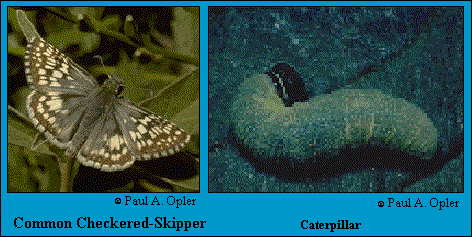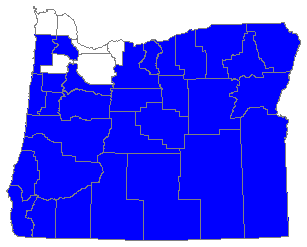 |
 

 |



Common Checkered-Skipper (Pyrgus communis [Grote])
Wing span: 1 - 1 1/2 inches (2.5 - 3.8 cm).
Identification: Upperside of male is blue-gray; female is black. Both sexes have large white spots which form median bands across both wings. Fringes of male checkered but black checks often reach only halfway to edge of fringe. Male has a costal fold enclosing scent scales on the upperside of the forewing. Underside is dull white with dark gray or olive bands. Spots of the hindwing marginal row are very small; spots of the submarginal row are larger. This species is separated from the white checkered skipper with confidence only by dissection and examination of the male genitalia.
Life history: Males patrol in swales most actively in the afternoon, and mating takes place then. Females lay eggs singly on leaf buds and tops of leaves. Adults roost exposed on a tall plant beginning in late afternoon. Caterpillars make folded-leaf nests in which they live and feed, and fully-grown caterpillars hibernate.
Flight: February-October in the Deep South, March-September in the north.
Caterpillar hosts: Several plants in the mallow family (Malvaceae) including globemallows (Sphaeralcea), mallow (Malva), hollyhock (Althaea), alkali mallows (Sida), velvet-leaf (Abutilon), and poppy mallow (Callirhoe).
Adult food: Nectar from white-flowered composites including shepherd's needles, fleabane, and asters; also red clover, knapweed, beggar's ticks, and many others.
Habitat: Open, sunny places with low vegetation and some bare soil including prairies, meadows, fields, roadsides, landfills, yards, gardens, pastures, openings and trails in woods.
Range: Most of the temperate United States south to Gulf coast, w. Texas, se. Arizona, southern California, and mountains of northern Mexico. Colonizes as far north as central Alberta, southern Ontario, and southern New England. It cannot survive very cold winters and may not be a permanent resident north of the 40th parallel.
Conservation: Not usually required.
The Nature Conservancy Global Rank: G5 - Demonstrably secure globally, though it may be quite rare in parts of its range, especially at the periphery.
Management needs: None reported.
References:
Bailowitz, R. A., and J. P. Brock. 1991. Butterflies of southeastern Arizona.
Sonoran Arthropod Studies, Inc., Tucson, Arizona. 342 pages.
Emmel, T.C. and J.F. Emmel. 1973. The butterflies of southern California. Natural
History Museum of Los Angeles County, Los Angeles. 148 pages.
Ferris, C.D. and F.M. Brown. 1981. Butterflies of the Rocky Mountain States.
University of Oklahoma Press, Norman. 442 pages.
Garth, J.S. and J.W. Tilden. 1986.California Butterflies. University of California
Press, Berkeley and Los Angeles. 246 pp, 24 plates.
Layberry, R.A., P.W. Hall, and J.D. Lafontaine. 1998. The Butterflies of Canada.
University of Toronto Press, Toronto. 282 pages, 32 color plates.
Neck, R.W. 1996. A field guide to butterflies of Texas. Gulf Publishing Co.,
Houston, Texas. 323 pp.
Opler, P.A. 1999. A field guide to western butterflies. Houghton-Mifflin Co.,
Boston, Mass. 540 pages, 44 color plates.
Opler, P. A. and V. Malikul. 1992. A field guide to eastern butterflies. Peterson
field guide #4. Houghton-Mifflin Co., Boston. 396 pages, 48 color plates.
Scott, J. A. 1986. The butterflies of North America. Stanford University Press,
Stanford, Calif. 583 pages, 64 color plates.
Stanford, R. E. and P. A. Opler. 1993. Atlas of western USA butterflies including
adjacent parts of Canada and Mexico. Denver and Fort Collins, CO.
Author: Jane M. Struttmann and Paul A. Opler
State and Regional References:
Dornfeld, E. J. 1980. The Butterflies of Oregon. Forest Grove, Ore., Timber
Press.
Hinchliff, J. 1994. An atlas of Oregon Butterflies. Oregon State University
Bookstore, Corvallis.
Hinchliff, J. 1994. The distribution of the butterflies of Oregon. Evergreen
Aurelians. Oregon State University Bookstore, Corvallis, 176 pp. + map.
Opler, Paul A. 1999. Peterson Field Guide to Western Butterflies, revised
edition. Houghton Mifflin Co., Boston, Mass.
Stanford, R.E. and P.A. Opler. 1993. Atlas of Western USA Butterflies.
Privately published, Denver, Colo.
Tilden, J.W. and A.C. Smith. 1986. A Field Guide to Western Butterflies.
Houghton Mifflin Co., Boston, Mass.

